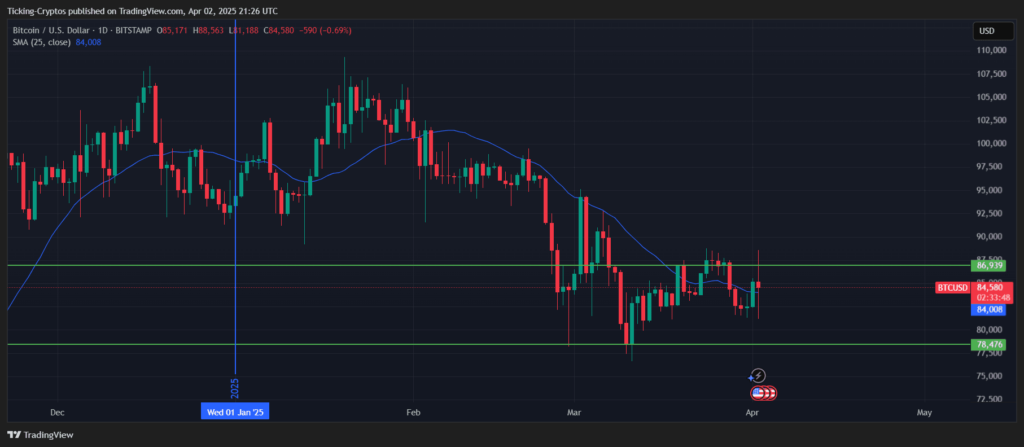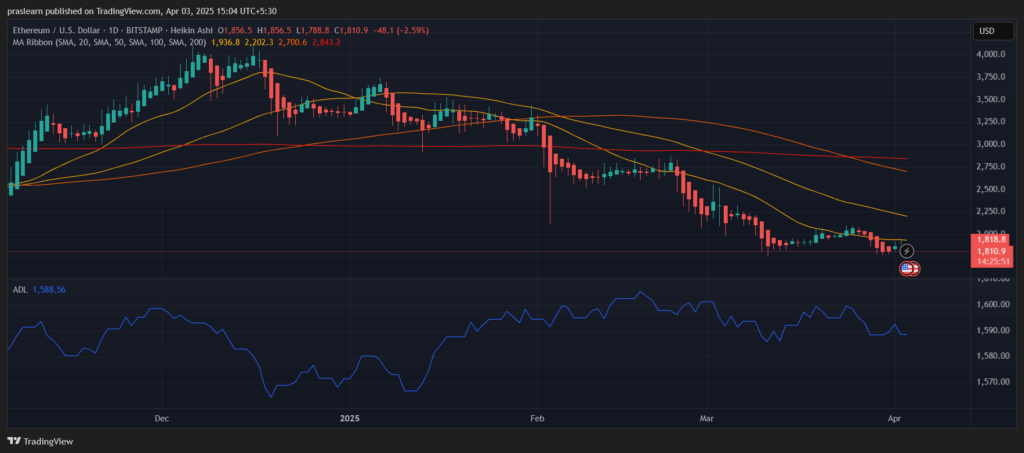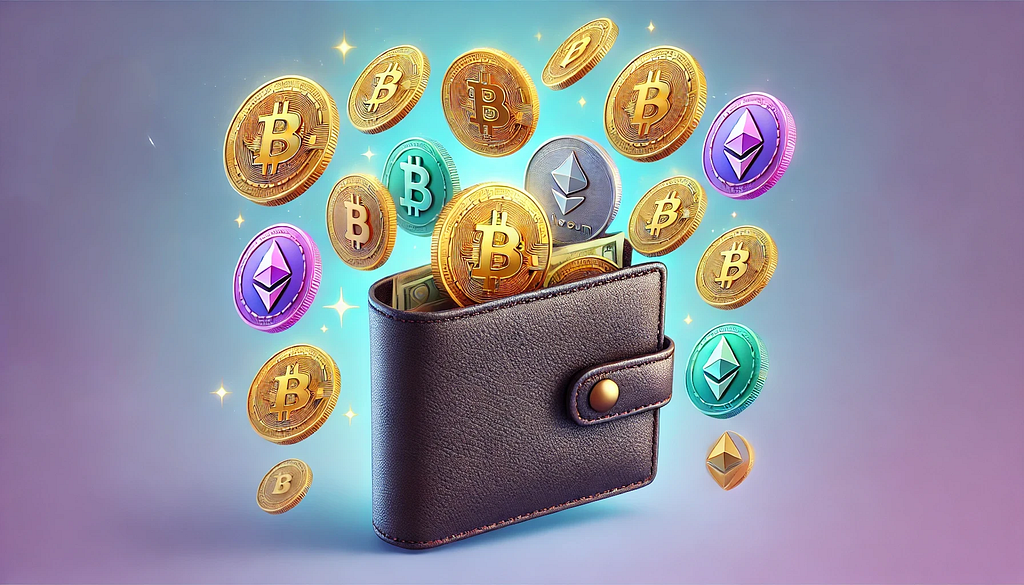Your altcoin bags are wrecked. And they keep getting worse. But if history tells us anything, this might be the exact moment smart…
Related Posts

Bitcoin Price Analysis: Q1 2025 Performance and BTC Price Prediction
Bitcoin had a turbulent first quarter in 2025, with prices dropping from $93,400 to $82,510 by the end of March. What does this mean for the crypto market moving forward?

Big ETH News: Ethereum Price to Crash to $600?
Big news, major sell-offs, and warning signs on the charts are raising serious alarms. Could this be the biggest ETH shake-up yet?

How to Build a Crypto Wallet Like Simple App?

The crypto market has witnessed an unprecedented surge in adoption over the past decade. According to recent reports, global cryptocurrency ownership surpassed 560 million users in 2024, marking a 30% increase from the previous year. Projections indicate that by 2025, crypto adoption could reach 861 million users, further cementing its role in mainstream finance.
With this growth, the demand for secure and easy-to-use cryptocurrency wallets has skyrocketed. Whether for investment, trading, payments, or decentralized finance (DeFi), users need reliable solutions to manage digital assets. Wallet applications have become the backbone of crypto transactions, allowing users to buy, sell, and store digital currencies conveniently.
Why Build a Crypto Wallet Like Simple App?
Developing a custom crypto wallet provides numerous advantages for both businesses and individual developers. Unlike third-party wallets that offer limited customization, a proprietary wallet can be tailored to meet specific user needs.
Some benefits of building a wallet like Simple App include:
- Full control over security measures — Customize security protocols like multi-factor authentication, biometric login, and private key encryption.
- Seamless user experience (UX) — Create a user-friendly interface that enhances accessibility for both beginners and advanced users.
- Branding and monetization — A custom wallet allows businesses to introduce premium features, transaction fees, and subscription models.
- Multi-currency support — Users prefer wallets that can manage multiple cryptocurrencies without relying on external services.
Understanding the Fundamentals of a Crypto Wallet
What is a Cryptocurrency Wallet?
A cryptocurrency wallet is a digital tool that enables users to store, send, and receive digital assets securely. Unlike traditional wallets, which hold physical money, crypto wallets manage private keys and public keys, which allow users to access their funds on the blockchain.

- Private Key — A unique cryptographic key that grants full access to the user’s digital assets. It must be kept secure and confidential.
- Public Key — A cryptographic code that acts as the wallet’s receiving address. It can be shared with others to receive funds.
- Wallet Address — A shorter, user-friendly version of the public key used for transactions.
Different Types of Crypto Wallets
There are several types of crypto wallets, each with unique benefits and trade-offs.
1. Hot Wallets vs. Cold Wallets
- Hot Wallets: Connected to the internet for quick access but are more vulnerable to hacking. Examples include mobile, web, and desktop wallets.
- Cold Wallets: Stored offline, providing maximum security against cyber threats. Examples include hardware wallets and paper wallets.
2. Custodial vs. Non-Custodial Wallets
- Custodial Wallets: A third party (like an exchange) manages private keys on behalf of users. Convenient but less control and more security risks.
- Non-Custodial Wallets: Users control their own private keys, providing enhanced security and decentralization.
3. Hardware Wallets vs. Software Wallets
- Hardware Wallets: Physical devices that store private keys offline (e.g., Ledger Nano X, Trezor).
- Software Wallets: Apps installed on mobile or desktop devices that provide easy access to funds (e.g., MetaMask, Trust Wallet).
How Crypto Wallets Work
Crypto wallets interact with the blockchain network to process transactions securely.
Here’s how a transaction works:
- The user enters the recipient’s wallet address and the amount to be sent.
- The wallet signs the transaction using the private key and submits it to the blockchain.
- Miners or validators verify the transaction and confirm it on the network.
- The transaction is permanently recorded on the blockchain, and funds are transferred.
Key Features Every Crypto Wallet Must Have
Multi-Currency Support
A modern crypto wallet should support multiple cryptocurrencies, including Bitcoin (BTC), Ethereum (ETH), and stablecoins like USDT.
Why it’s important:
1.Users often invest in various assets and prefer a single wallet for convenience.
2.Interoperability with different blockchains increases usability.
3.Supporting fiat-crypto conversion enhances mainstream adoption.
Robust Security Architecture
Security is non-negotiable for any crypto wallet. Even small vulnerabilities can lead to hacks, asset loss, or fraud.
Key security features include:
- Multi-Factor Authentication (MFA) & Biometric Login — Prevents unauthorized access.
- End-to-End Encryption — Ensures sensitive data remains private.
- Private Key Management — Offers secure ways to store and back up private keys.
Seamless User Experience (UX) and Intuitive UI
A well-designed user interface enhances adoption by making crypto transactions straightforward.
- Easy onboarding — Simplified sign-up process with quick KYC verification.
- Minimalist design — A clean layout that avoids overwhelming new users.
- Transaction transparency — Clear fee structures and real-time confirmations.
QR Code and NFC Payment Integration
Quick payment options like QR scanning and Near Field Communication (NFC) allow seamless transactions in physical stores.
Why it matters:
1.Reduces friction for crypto payments.
2.Encourages real-world adoption of digital assets.
3.Increases merchant adoption of cryptocurrencies.
Fiat-to-Crypto On-Ramp
Most users prefer buying crypto directly rather than transferring funds from external exchanges.
- Enables instant purchases using:
- Debit/credit cards
- Bank transfers
- Apple Pay/Google Pay integrations
Real-Time Price Alerts and Portfolio Tracking
Providing real-time crypto market updates helps users make informed investment decisions.
- Features to include:
- Live price charts
- Portfolio valuation tracking
- Customizable alerts for price fluctuations
Push Notifications and Transaction Alerts
Instant notifications keep users informed about wallet activity, improving engagement and security.
- Key benefits:
- Alerts users of incoming/outgoing transactions.
- Provides security updates and fraud alerts.
- Sends reminders for market trends and news.
Planning the Development of Your Crypto Wallet
Embarking on the journey to create a crypto wallet akin to Simple App? Let’s break down the essential steps to ensure your wallet not only meets user expectations but also stands out in the bustling crypto market.

Defining the Purpose and Target Audience
Identifying User Needs and Industry Use Cases
First things first: Why are you building this wallet? Understanding the core purpose will guide every subsequent decision. Are you aiming to provide a secure storage solution, facilitate seamless transactions, or perhaps both?
Consider the diverse applications of crypto wallets across various sectors:
- E-commerce Integration: Enabling users to make purchases using cryptocurrencies, streamlining the checkout process.
- Healthcare Records: Allowing patients to securely store and share medical records using blockchain technology.
- Travel and Hospitality: Simplifying bookings and payments with crypto, enhancing the travel experience.
Market Research and Competitive Analysis
Studying Top-Performing Crypto Wallets and Their Differentiating Features
To carve out a niche in the crypto wallet landscape, it’s crucial to analyze existing players:
- Coinbase Wallet: Celebrated for its user-friendly interface, making it ideal for crypto newcomers.
- Ledger Nano X: Offers robust security as a hardware wallet, appealing to users prioritizing asset protection.
- MetaMask: Specializes in Ethereum-based assets and decentralized applications (DApps) integration.
Compliance and Regulatory Considerations
Navigating Legal Requirements for Launching a Crypto Wallet Globally
The regulatory landscape for cryptocurrencies is akin to shifting sands, varying significantly across jurisdictions. Key considerations include:
- Anti-Money Laundering (AML) and Know Your Customer (KYC) Regulations: Implementing robust user verification processes to prevent illicit activities.
- Licensing Requirements: Understanding whether your wallet service classifies as a Money Services Business (MSB) and obtaining necessary licenses.
- Data Protection Laws: Ensuring compliance with regulations like GDPR to safeguard user information.
Choosing the Right Technology Stack
Embarking on the development of a crypto wallet like Simple App requires meticulous selection of the technology stack. This choice influences the wallet’s performance, security, and scalability. Let’s delve into the critical components of this stack.
Selecting a Blockchain Network
Comparing Bitcoin, Ethereum, Binance Smart Chain, Solana, and Other Layer 2 Solutions

The foundation of your crypto wallet is the blockchain network it supports. Each network offers distinct advantages:
- Ethereum: Renowned for its robust smart contract capabilities and a vast ecosystem of decentralized applications (DApps). However, it has faced scalability challenges, leading to higher transaction fees.
- Binance Smart Chain (BSC): Offers faster transaction times and lower fees compared to Ethereum, making it a popular choice for DApp development.
- Solana: Known for high throughput and low transaction costs, Solana is gaining traction among developers seeking scalability.
- Bitcoin: Primarily a digital currency, Bitcoin’s scripting language is limited, but it remains a widely recognized and secure network.
- Layer 2 Solutions: Technologies like the Lightning Network for Bitcoin and Plasma for Ethereum aim to enhance scalability and reduce fees by processing transactions off the main blockchain.
Programming Languages and Frameworks
Best Languages for Wallet Development: Solidity, Python, JavaScript, Kotlin, Swift
Selecting the appropriate programming language is pivotal for efficient development:
- Solidity: The primary language for Ethereum smart contracts, known for its straightforward syntax and robust tooling.
- Python: Valued for its simplicity and readability, Python is suitable for backend services and scripting within blockchain applications.
- JavaScript: Essential for web-based wallets, especially when utilizing frameworks like Node.js for server-side operations.
- Kotlin: Preferred for Android app development, offering modern features and seamless interoperability with Java.
- Swift: The go-to language for iOS applications, known for its performance and safety features.
Integrating APIs and SDKs
Leveraging Blockchain APIs (Infura, Alchemy, Moralis) for Smooth Development
APIs and SDKs streamline the development process by providing pre-built functionalities:
- Infura: Offers scalable access to Ethereum and IPFS networks, facilitating seamless integration without running full nodes.
- Alchemy: Provides a suite of developer tools and enhanced APIs for Ethereum, focusing on reliability and scalability.
- Moralis: Delivers a comprehensive backend infrastructure for DApps, including real-time database and user authentication.
Cloud Infrastructure and Database Selection
Secure and Scalable Hosting Solutions for Wallet Operations
A resilient cloud infrastructure is vital for the performance and security of your crypto wallet:
- Amazon Web Services (AWS): Offers a broad range of services with a strong emphasis on security and compliance, suitable for scalable applications.
- Google Cloud Platform (GCP): Provides robust data analytics and machine learning capabilities, beneficial for advanced wallet features.
- Microsoft Azure: Known for its enterprise-grade solutions and seamless integration with Microsoft products.
When selecting a database, consider:
- SQL Databases: Ideal for structured data and complex queries.
- NoSQL Databases: Suitable for flexible data models and scalability, accommodating diverse data types.
Conclusion
Building a crypto wallet like Simple App requires careful planning, the right technology stack, and a user-first approach to security and functionality. From defining your target audience and conducting market research to selecting a blockchain network, programming languages, and cloud infrastructure, every step plays a crucial role in shaping your wallet’s success. Integrating robust security measures, seamless transaction capabilities, real-time market data, and fiat gateways ensures an optimal user experience. Compliance with regulatory requirements adds credibility and longevity to your platform. As the crypto space evolves, staying ahead with innovative features like Web3, DeFi integration, and AI-driven security will set your wallet apart. With a strategic approach and the right execution, you can create a powerful, scalable, and secure crypto wallet that meets the demands of modern users and the rapidly expanding digital economy.
How to Build a Crypto Wallet Like Simple App? was originally published in Coinmonks on Medium, where people are continuing the conversation by highlighting and responding to this story.

